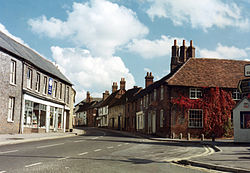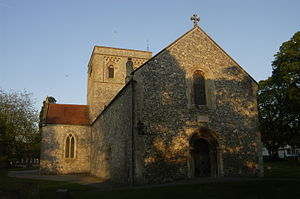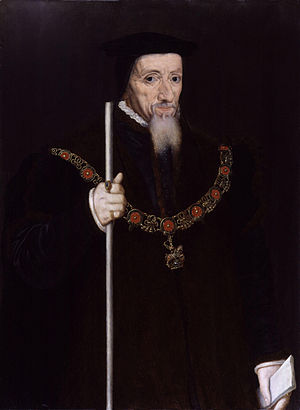Kingsclere
| Kingsclere | |
| Hampshire | |
|---|---|
 George Street | |
| Location | |
| Grid reference: | SU527588 |
| Location: | 51°19’34"N, 1°14’39"W |
| Data | |
| Population: | 3,396 (2001) |
| Post town: | Newbury |
| Postcode: | RG20 |
| Dialling code: | 01635 |
| Local Government | |
| Council: | Basingstoke and Deane |
| Parliamentary constituency: |
North West Hampshire |
Kingsclere is a large village and parish in northern Hampshire adjacent to the border with Berkshire. Kingsclere is located near to Watership Down, the setting of Richard Adams' 1972 novel of the same name.
Contents
Geography
Kingsclere is situated approximately equidistant (eight miles) from the towns of Basingstoke and Newbury on the A339 road.
Village life
Kingsclere benefits from a long established friendly village culture[1] and many local organisations and volunteer groups.[2]
The village has a selection of local shops and businesses, healthcare services, a primary school[3] and varied outdoor facilities. It also has an extensive network of green lanes and paths, glades and the Kingsclere stream. Treasured areas known by the villagers, such as 'the rec.', 'the ducks' and 'shepherds steps' are usually overlooked by the casual visitor, but add greatly to village life.
There are three Christian churches, Kingsclere Methodist Church,[4] Saint Mary's Anglican Church,[5] and Saints Peter and Paul Catholic Church.
Local facilities include the village club, the Holding field and the Fieldgate Centre[6] which lies on the outskirts of the village and adjoins the rugby and football grounds. The centre was built in 1996 at a cost of £1.6 million
The parish council meets in the village club monthly, except for August and December.[7]
Kingsclere is a conservation area[8] and has a village plan.[9]
History

Kingsclere can trace back its history to a place identified as belonging to King Alfred in his will between 872 and 888, the 'clere' possibly meaning 'bright' or 'clearing'.[11]
Local legend asserts that King John was troubled by a bedbug during a night in a Kingsclere inn, when prevented by fog from reaching his lodge on Cottington's hill. He ordained that the church should erect and evermore maintain upon its tower a representation of the creature which disturbed his sleep.[11]
Fairs
In 1218 the king ordered that the market which had been held in Kingsclere on Sundays should in the future be held on Saturdays.[12] Warner, writing in the 18th century, mentions a well-frequented market on Tuesdays, and fairs the first Tuesday in April and the first Tuesday after 10 October.[13] In 1848 the market was still held on Tuesdays, but had fallen very much into disuse, only a few farmers meeting at the Swan Inn with samples,[14] and it probably ceased altogether about 1850. The fairs continued (c. 1911) to be held—on Whit Tuesday for pleasure on Ashford Hill and the Tuesday after Old Michaelmas Day for hiring servants and pleasure in the market place.[15]
Inns
The former Falcon Inn, in Swan street, was one of the oldest in Hampshire, is especially interesting as being at one time in the possession of William Warham, Archbishop of Canterbury, who in 1510 gave it to Winchester College upon trust for the maintenance and support of the scholars upon its foundation. The original 'Crowne' Inn is mentioned in the parish register in 1611, and the 'Golden Faucon' in 1628. The modern Crown Inn was built in 1853, and the Swan Inn dates back to well before 1848, and its sign proclaims it a 15th C. Rooming Inn.[16]
In popular culture
The nearby Watership Down is the setting for the 1972 novel of the same name by Richard Adams. Watership Down was also the site of the 1982 World Field Archery Championship put on by the Overton Black Arrows archery club from the nearby village of Overton. The actress Lavinia Fenton, most famous for her role as Polly Peachum, was lover and then wife of Charles Powlett, 3rd Duke of Bolton of the parish.
Village organisations and activities
There are many activities[17] that take place within the village, such as dancing.[18] There is a Chinese restaurant called Gar Ho and an Italian restaurant called Sasso's.
People from Kingsclere
- William Fauconer (died 1412), JP (Hants, 1407–1412), MP for Hampshire, 1407 and 1411, buried in St Mary's.[19][20]
- William Paulet, 1st Marquess of Winchester, a local magnate and statesman, of Old Basing and parts of Kingsclere.
- Lord Lloyd-Webber lives at Sydmonton Court, near Kingsclere.[21]
- Clare Balding, TV presenter, grew up in Kingsclere.[22]
- Tom Croft, England International Rugby Player grew up in Kingsclere.[23]
- John Porter, race-horse trainer.
- Various Dukes of Bolton, sometime patrons and owners of parts of Kingsclere.
Frobury
The manor of Frobury is the western part of the modern parish of Kingsclere. Frobury was in the possession of Ranulf de Broch [Broc] (died 1179 or 1187), usher and chief marshal of the household to Henry II, and his widow (when assigned in dower?), Damietta de Gorron (died 1204), the lady of Chetton, Eudon and Berwick (co. Salop).[24] Their daughter Edelina de Broch (died 1220) was returned by the Testa de Nevill as 'holding £6 worth of land in the vill of Frobury of the king in chief by the serjeanty of guarding the king's door'. Between 1217–1223, a grant of money was made by Edelina to the Canons of the Church of Saint John the Baptist, Sandleford of 40s. and 8d. from her inheritance in Frollebire [Frobury] for the maintenance of a Canon Chantry Priest, for the souls of herself, her parents Randulf de Broch [Broc] and Damietta de Gorron, and her husband, Stephen de Turneham (died 1214).[25]
The widow Edelina left by her husband five daughters and co-heirs, Maud or Mabel the wife of Thomas de Bavelingham, Alice the wife of Adam de Bending, Eleanor who married Roger de Leyburn, Eleanor who married Ralph Fitz Bernard, and Beatrice the wife of Ralph de Fay (1), Hugh de Neville (2) and Hugh de Plessetis (3).
The grant to Sandleford was confirmed by Edelina's daughter Beatrice de Fay (died before 1245), widow of Ralph de Fay, (she married secondly Hugh de Neville (died 1234) was the Chief Forester under the kings Richard I, John, and Henry III of England), to the Church of Saint John the Baptist, Sandleford, and the Canons, of rents etc, in Frollebire [Frobury], which Edelina de Broc, her mother gave them.[26] Her third husband Hugh de Plessetis (de Playz) had Beatrice excommunicated circa 1241 because she would not divorce him. Frobury fell as her share to Beatrice, probably the eldest daughter, and passed from her to her daughter Philippa the wife of William de Nevill, who in the middle of the 13th century was stated to be holding 'half a hide [circa 50 acres] in Frobury of the old enfeoffment by the serjeanty of guarding the door of the queen's chamber'. In 1249 Philippa de Nevill granted Frobury in free marriage to William de Wintershull [Wintershill], who had married her daughter Beatrice, and from this date Frobury continued in the Wintershull family for about two centuries. William de Wintershull obtained licence to impark his wood of Frobury [Frobury park copse], which covered an area of 10 acres, in 1260, and died seised of the manor of Frobury in 1287.[27][28][29][30] In circa 1546 William and Joan Unwin sold the manor to William Paulet, Lord St John.[31]
'On 21 October 1644 Charles I intending to relieve Basing House marched hither from Whitchurch, but finding the enemy so greatly his superior in cavalry, after one night's halt he continued his march towards Newbury', so wrote the Victoria County History in 1911.[32] According to Captain Richard Symonds, the author of Diary of the Marches of the Royal Army, (published 1869, page 142), the house at which the king spent the night was Frobury Manor House, about a mile northwest of the town, his host being Robert Tower.[33] Appropriately, Basing House and Frobury manor both belonged at that time to John Paulet, 5th Marquess of Winchester.
North Oakley and other manors
In addition to Frobury the manors of North Oakley, Hannington, Sydmonton, Edmundsthorp Benham (Headley, and Beenham Court or Cheam School) and Ecchinswell at some time were associated with the parish of Kingsclere.
Sources
- ↑ Margaret Ingram's book 'Kingsclere – A place and its people (1987)'
- ↑ Kingsclere local organisations and volunteer groups
- ↑ Kingsclere primary school
- ↑ "Kingsclere Methodist Church, Kennet and Test Valley Circuit". http://www.kennet-and-test-valleymethodist.org.uk/. Retrieved 8 October 2010.
- ↑ "Saint Mary's Anglican Church". http://www.clerewoodlands.org.uk/. Retrieved 15 January 2007.
- ↑ Fieldgate Centre
- ↑ "Kingsclere Parish Council". http://www.kingsclere-pc.org.uk/. Retrieved 13 May 2013.
- ↑ Kingsclere conservation Area
- ↑ Kingsclere village plan
- ↑ VCH, Hampshire, 1911. http://www.british-history.ac.uk/report.aspx?compid=56801
- ↑ 11.0 11.1 "Kingsclere Heritage Association". The Bedbug Recorder (Edition One). http://www.kingsclere.org.uk. Retrieved 17 October 2010.
- ↑ Close, 2 Henry III, m. 2
- ↑ Warner's History of Hampshire, 1795
- ↑ Post Office Directory of Hants (1848)
- ↑ Victoria County History, A History of the County of Hampshire: Volume 4, William Page (editor), 1911.
- ↑ Hants N. and Q., v, 103–4, and Ex inform, the Rev. A. T. Finch, via VCH, Hants, 1911, ibid
- ↑ Kingsclere village diary
- ↑ "Lynden School of Dance". http://www.lyndendance.co.uk. Retrieved 13 May 2013.
- ↑ Bishop Wykeham's bailiff of Sutton, Alresford and Cheriton, Hants 18 April 1401-c.1405; Bishop Beaufort's bailiff of Highclere, c. Michaelmas 1405–1412.
- ↑ L.S. Woodger in The History of Parliament: the House of Commons 1386–1421, edited by J.S. Roskell, L. Clark, C. Rawcliffe, 1993.
- ↑ "20 famous people with links to the Basingstoke area". http://www.basingstokegazette.co.uk/news/11040725.20_famous_people_with_links_to_the_Basingstoke_area/?ref=rss. Retrieved 15 February 2016.
- ↑ "20 famous people with links to the Basingstoke area". http://www.basingstokegazette.co.uk/news/11040725.20_famous_people_with_links_to_the_Basingstoke_area/?ref=rss. Retrieved 15 February 2016.
- ↑ Kitson, Robert (20 March 2009). "England's Mr Anonymous on the fast track to world stardom" (in en-GB). The Guardian. SSN 0261-3077. http://www.theguardian.com/sport/2009/mar/21/tom-croft-profile-england-six-nations. Retrieved 15 February 2016.
- ↑ Danietta may have brought the lands at Frollebury [Frobury] to her husband on their marriage.
- ↑ 'Such money to be received from Henry de Wudecote, Walter de Clera, Hugh de Swantun, Joceus de Brikeull, William Furmentin of Spenes, Symon Cath, Wulfric de Marisco, Nicholas de Wullavintun, John Trull. Witnesses: Peter [de Rupibus], Bishop of Winchester, William Prior of Syreburn [Sherbourne], Dan Roger de Leburna, William de Stanes and William de Sorewull, Sheriff of the County of Southampton, Henry de Wudecott, Henry de Fernlehd, Thomas Croc, Roger Lanceleue, John de Hamtun, John de Wultun, Walter de Clera, William de Edmundesdrop, William Toli seneschel of the donor, Master Walter de Syreburne, Robert Fitzbernard of Hamtun, Richard, Clerk of Clera, Henry Blakemy, Wlater Clerk of the donor, Hugh de Swantun, Master Walter, Joceus de Brikeull, Bartholomew Crok, Richard Fitzruald, John his brother, Thomas the clerk.' (Muniments of St George's Chapel, Windsor: SGC XV.54.5)
- ↑ Witnesses: William Prior of Sireburn [Sherbourne], Henry de Wodecot, Thomas Croc, Walter de Clera, William de Edmundesthrop, John de Wltun, Richard de Quercu, John Lanceleuee, Bartholomew Croc, Richard Serviens, Auger Nepos of donor, John de Wodecot, Stephen de Hamtun.
- ↑ A History of the County of Hampshire: Volume 4, Victoria County History, London, 1911.
- ↑ Fine Rolls of King Henry III, essay by Stephen Church, Fine of the Month: February 2011: The Excommunication of Beatrice de Faye: http://www.finerollshenry3.org.uk/content/month/fm-02-2011.html
- ↑ muniments of St George's Chapel, Windsor: SGC.
- ↑ SGC XV.54.8
- ↑ A History of the County of Hampshire: Volume 4, Victoria County History, London, 1911.
- ↑ George Nelson Godwin, The Civil War in Hampshire, pages 274, edited by Charles Edward Long, 1904.
- ↑ 'Munday, 21 Oct.. His Majesty lay at King's-Cleer (at Mr. Tower's) at Frobury, a moated house, seven miles from Basing, the troop at Newtown, the head-quarters of the horse at Newbury...', quoted in Symonds (1904) and G. N. Godwin, loc. cit., page 274.
Further reading
- Kingsclere – A place and its people (1987)
Outside links
| ("Wikimedia Commons" has material about Kingsclere) |
- Clare, Clere, and Clères A paper on the origin of the name.
- Kingsclere Parish Council
- Kingsclere: Its heritage and genealogy
- Kingsclere, history from the website of Hampshire County Council
- A Vision of Britain through Time: Kingsclere



